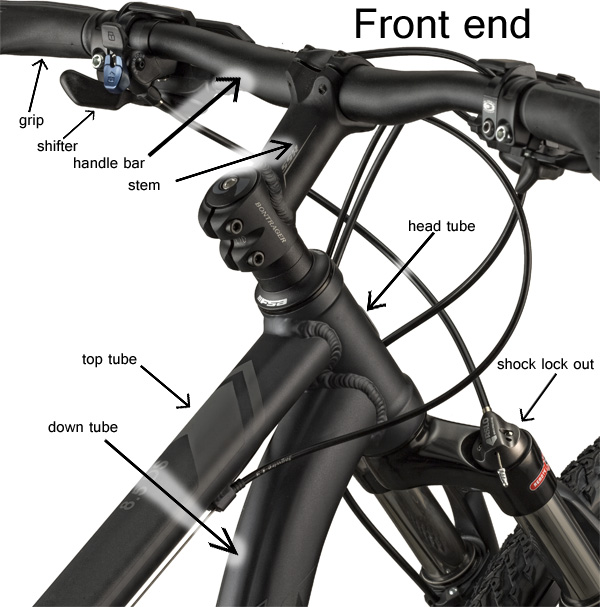
The front end of the bicycle is exactly that. It is the central nervous system, the helm of the ship, the cockpit of the plane. Here you will find the means for steering, braking, leverage for balance, and gear selection. Many other important things can be added here such as, lights, cycling computer (for speed, odometer, distance, clock, etc), warning bell/horn, mirrors, basket, and many MANY other gizmos can be added to the handlebar.
List of terms from above diagram:
- Grip: This is simply the rubber grip that pads the handlebar and gives you something to get a firm hold of.
- Shifters: These control the gear shifters aka: "derailleurs" that derail the chain from the current gear. The left shifter controls the front gear derailleur and the right side controls the rear derailleur.
- Handlebar: Is just that a bar with handles. It is the foundation for all of the controls of the bicycle. It is your "dashboard".
- Stem: The stem links the front wheel to the handlebar. The handlebar, stem, and front fork (which holds the front wheel) are not part of the bicycle "frame". Although they are connected THROUGH the frame they are not fixed to it.
- Head Tube: The head tube IS part of the bicycle frame. It is the hinge through which the handlebar, stem and fork pivot through.
- Shock Lock Out: I labeled this component because it stands out so obviously in this image. It is not a "basic" part at all. It is very specific to specific types of bikes. Shown is a shock lock out with remote switch which is attached to the handlebar. A shock lock out does just that, it locks the shock to the "off" position making it so that it does not compress and absorb impacts from rough terrain caused by rocks and roots. Shock lock outs are only available on SOME forks, usually on mountain bikes and of those forks that DO have shock lock outs, most do not have a "remote lock out" switch. It's a nice feature that makes comfort, controllable from a convenient location.
- Top Tube: This is the top of the frame that connects the tube that holds your seat with the tube that holds the head tube.
- Down Tube: This tube connects your pedals to the head tube.
- Brake Lever: (Shown below) activates your brake system.
![]()
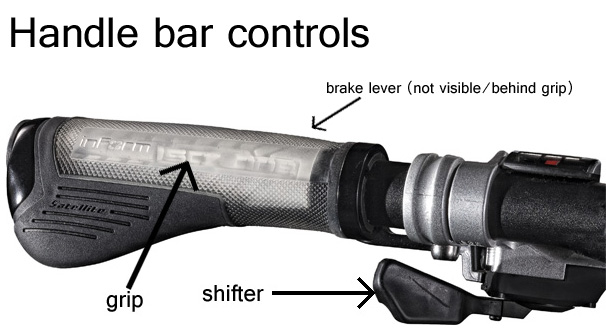
![]()
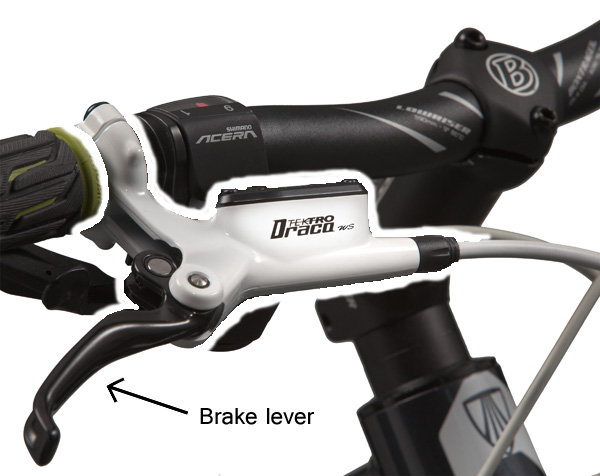
![]()
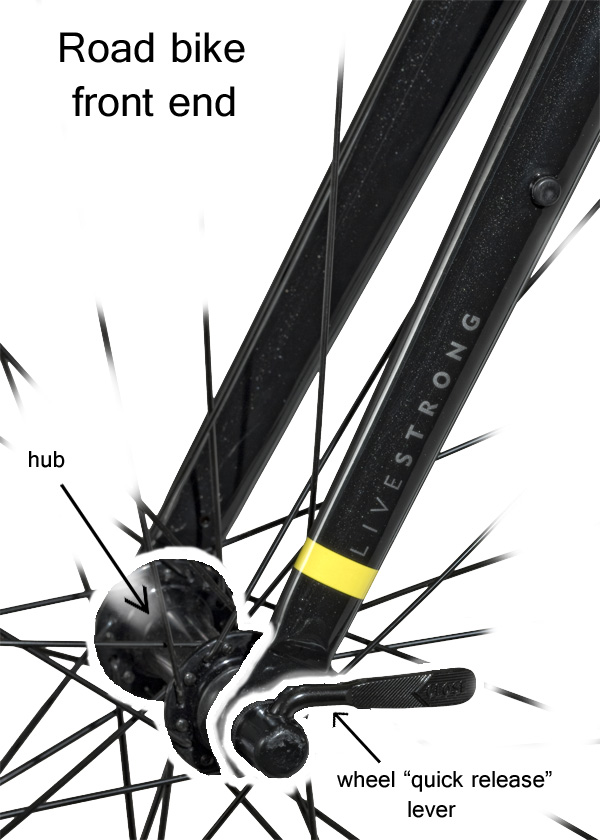
Shown above is a the front end of a road bike wheel section. The vertical bars are called "Fork Blades" and they hold the front wheel on by the "Hub".
- Hub: The hub is actually a bunch of parts called an "assembly" that houses the axle (which in this case is a Quick Release Lever style), the bearings (not shown, inside of hub body) and the hub has holes in it through which the spokes fit to "lace" the rim and tire on.
- Quick Release: The quick release is a type of axle that makes wheel removal quick and simple. You do not have to use wrenches to remove a quick release lever.
I know, I know, it's a big world Charlie Brown... but stick with me... all of this will come together shortly.
![]()
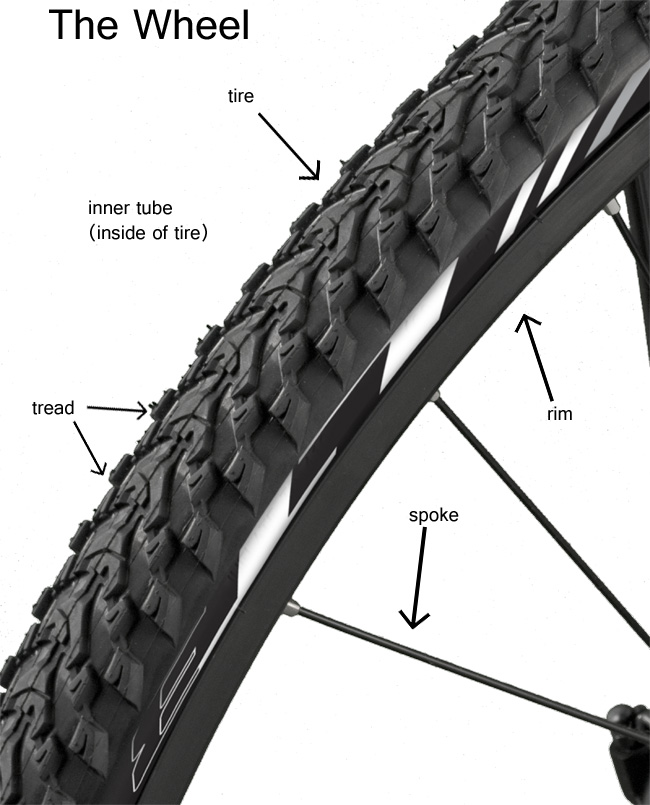
The wheel is a group of smaller parts all assembled together. From the middle to the outside, the wheel is the axle, bearings, hub body, spokes, rim, inner tube, and tire.
List of parts from diagram above:
- Tire: Sometimes called a "carcass". This is LITERALLY where the rubber meets the road. Shown is a mountain bike wheel with a heavy tread to grip loose textured surfaces like sand, gravel, rocks and roots.
- Inner tube: This is the thin rubber membrane that can be replaced on the inside of the tire. The inner tube seals the air inside the tire.
- Tread: Shown in this example is the "knobbies" of a mountain bike tire. The tread grips the surface of whatever you're riding on. When it comes to mountain biking, be sure to match the tread of the tire with the riding situation you will be in. The tread of a trail tire is not the same as that of a sand tire or that of a mud tire, or that of a ice tire. And the same goes for road and hybrid tires. A road tire's tread, although less distinct than a mountain tire, comes in several different patterns and strengths. Such as, there are economy tires which are designed to last a long time for regular commuting. Commuter tires are not as light as high performance tires but they are more puncture resistant, they have a harder rubber compound that extends your range and usable lifespan. And there are high performance tires who's rubber compound is "sticky-er" for grippy security in high speed turns. These high performance tires have a tendency to wear faster much like the tires on a formula-1 race car but they are generally only used for races or for steep mountain road riding. Ask us when you come in what kind of tire you will need for different rides you plan to take.
- Rim: The rim basically interlocks with the tire to hold the inner tube in securely. It also provides a sturdy spine to which the spokes can attach it to the hub. There are many different types of rims. And which we have no need to get into except to say that they are the skeleton to which the tires cling.
- Spokes: The spokes basically are the supports on which we ride. Fun facts: a single spoke of a bicycle that weighs 25 pounds and a rider who's weight is 150 supports 1/32 of half of your body plus your bicycle's weight riding on a level surface. That means that if you weigh 150 and your bicycle weighs 25 then each spoke supports about 2.73 pounds each! pretty cool huh? But don't worry, the weight limit of each spoke (even a common cheap spoke) is much MUCH higher than 3 pounds though.
Continue to center of a bicycle>>
![]()
Quick links to specific bicycle sections & parts:
Frame Terminology>>
Bicycle Front End>>
Bicycle Center>>
Bicycle Back End>>
Shocks>>
Brakes>>
Pedals & Shoes>>
